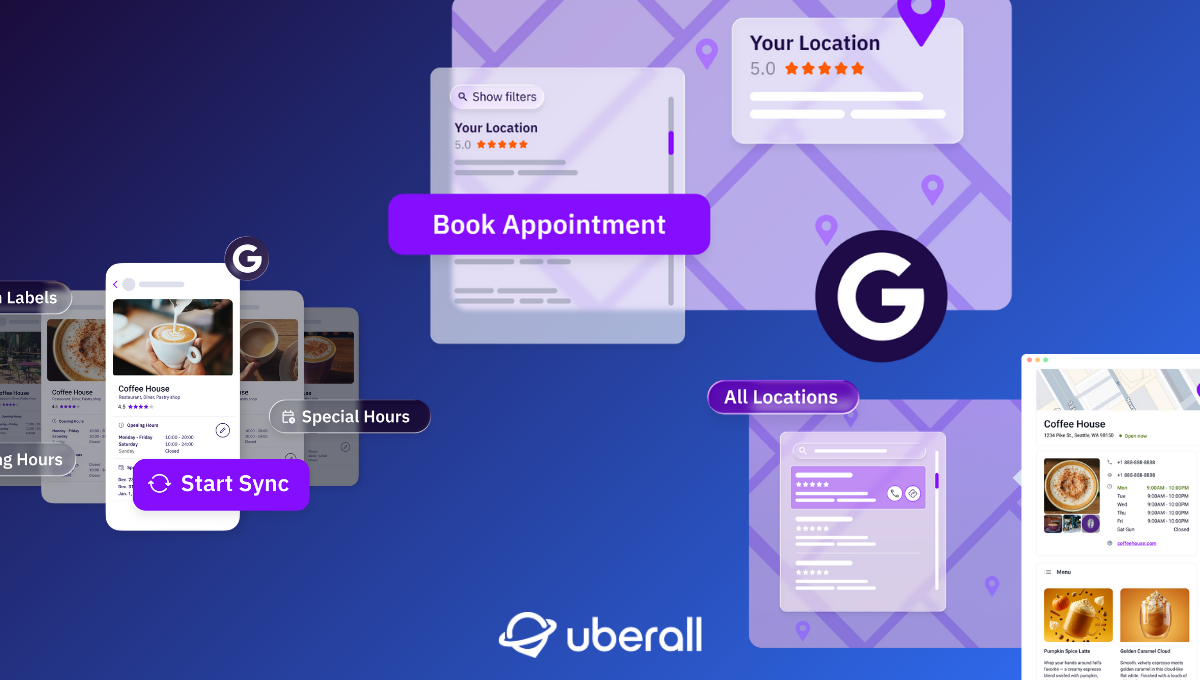
How to Optimize Your Apple Maps Business Listing
Get your business ranked on the #1 platform among Apple users. We explain in this blog article how to optimize your Apple Maps business listing.
While Google Maps often takes the spotlight, Apple Maps is an equally important tool for businesses, especially considering the vast number of iOS users worldwide. This blog article will guide you through getting your business on Apple Maps, improving your ranking, and understanding the key differences between Apple Maps and Google Maps.
Why Apple Maps Matters
Apple Maps hardly needs an introduction so we’ll just note that it serves as the default navigation app for millions of iPhone, iPad, and Apple Watch users.
Vast User Base
With millions of Apple users relying on it for directions, recommendations, and local searches, having your business listed on Apple Maps ensures you're visible to this substantial audience. And known for its seamless integration with the Apple ecosystem, Apple Maps offers a user-friendly interface and reliable location-based information.
Integration with Apple Ecosystem
Apple Maps is integrated with Siri, Spotlight, and Apple CarPlay, providing users with seamless access to location-based information. This integration means that when users ask Siri for recommendations or search via Spotlight, businesses listed on Apple Maps are more likely to be suggested.
Also, the platform integrates seamlessly with Tap to Pay for accepting Apple Pay on iPhones and Business Essentials, a subscription offering device management, cloud storage, and 24/7 support.
Increasing Accuracy and Features
Apple has significantly improved the accuracy and features of Apple Maps over the years. From detailed city guides to indoor maps of major locations, Apple Maps offers comprehensive tools for users and businesses alike.
How Do I Register My Business on Apple Maps
Before your business can shine on Apple Maps, the first crucial step is to get set up on Apple Business Connect. It’s Apple's portal for managing your business listing, ensuring you reach the right audience effectively.
What is Apple Business Connect?
Launched in January 2023, Apple Business Connect replaces the earlier Apple Business Register. It provides direct control and customization of your business information across all Apple platforms. You can add images, specify business categories, create events, and more.
The platform also enables direct customer interactions through calls, bookings, and special offers. Additionally, it features a simple verification process that typically completes within five business days.
How to Update Business Info on Apple Maps
Then, you’ll be able to claim or create your Apple Place Card—the equivalent to Google’s Business Profile as a comprehensive, customizable page for your business. Specifically, it displays essential location data while enabling your customers to interact with your brand.
Step 1: Claim or Create Your Apple Place Card
The first step to getting your business on Apple Maps is to sign in or create an Apple ID; then:
- Claim Your Business: Search for your business to see if it’s already listed. If it is, claim it—and if it’s not, you can add your business manually.
- Verify Your Business: Apple will send a verification code to your business phone number or email. Enter the code to verify your listing.
- Complete Your Place Card: Fill out all necessary information, such as business name, address, phone number ( = NAP data), website, and operating hours.
Step 2: Optimize Your Apple Place Card
Once your business is listed in the form of a Place Card, optimization is key to ensuring you rank higher and attract more customers.
- Add Photos: Add high-quality photos of your business to give your potential customers an impression of what they can expect.
- Use Showcases: Publish promotional posts about offers or seasonal products to provide customers with the most relevant, latest information.
- Manage Attributes: Add attributes to highlight essential details about your business, such as payment options, parking facilities, or unique features.
- Manage Status: Update the status field to inform customers whether your business is currently open or closed.
- Add Calls-to-Action: Set up direct links that allow customers to order food, book a reservation, schedule an appointment, and more.
- Ask for Check-ins: Encourage customers to check in at your location using Apple Maps, as this can boost your ranking.
- Engage with Customers: Respond to reviews and engage with customers to improve your online reputation.
- Consider Long-Tail Keywords: Optimize your Apple Maps listings with long-tail keywords to align with the way Apple users often phrase their voice queries (as they tend to use longer phrases when searching with Siri).
But most importantly: keep your information up-to-date, especially if there are changes in your operating hours or contact details.
Extra Tip: Local SEO
Local Search Engine Optimization is crucial for improving your ranking on Apple Maps; because you’ll reach a more targeted audience in your surroundings that is ready to buy.
- Complete Location Data: Ensure your NAP data and operational hours are thoroughly and accurately filled out to enhance your ranking on Apple Maps.
- Local Keywords: Incorporate local keywords like "Italian Pizza in New York" in your business description to appear as relevant search result.
- Consistent Information:: Ensure your business information is consistent across all platforms, including your website, social media, and other online directories.
How to Rank Higher on Apple Maps
To maximize your business's visibility on Apple Maps, it's important to understand and implement strategies that can improve your ranking.
Similar to other search engines, Apple Maps uses several factors to determine how businesses are ranked:
- Relevance: how well your business matches the user's search query.
- Location: proximity to the user’s location when they perform a search.
- Reviews: how high your business is rated / how well your business is reviewed
- Engagement: if users are interacting with your listing through check-ins etc.
Apple Maps vs. Google Maps
While both Apple Maps and Google Maps aim to provide users with relevant local business information, their ranking algorithms differ:
- Data Sources: Apple Maps relies on data from trusted partners (like Yelp) and user feedback, while Google Maps pulls data from a broader array of sources.
- User Interface and Features: Apple Maps focuses on a clean interface integrated with Apple’s ecosystem, while Google Maps offers more features like Street View and extensive user-generated content.
- Search and Discovery: Apple Maps integrates with Siri and Spotlight for search and discovery, while Google Maps leverages its extensive search engine capabilities.
But before you feel like you have to choose, both platforms are incredibly important. While Google Maps may offer more extensive features, many users prefer using default apps—and for Apple users, that’s Apple Maps.
So best ensure your business is optimized on both platforms to drive more traffic and increase customer engagement.
Leveraging Apple Maps for Business Growth
Utilizing Apple Maps effectively can propel your business forward. Here’s how optimizing your listing can make a difference:
- Online Visibility: With many users relying on Apple Maps for directions and local business searches, your presence can attract more local customers.
- Customer Experience: Users can easily find your location, contact information, and business hours, leading to higher satisfaction and more visits.
- Competitive Edge: Compared to others businesses, you’re easily discoverable, which leads to increased foot traffic and higher sales.
However, to effectively track and measure the success of your Apple Maps listing optimization, it’s essential to utilize detailed analytics.
Apple Place Cards Metrics
Key metrics to monitor include the number of views your listing receives, the frequency of customer actions such as calls or website visits, and changes in your ranking position. Additionally, tracking customer reviews and feedback can offer insights into areas for improvement.
Uberall’s comprehensive Apple Business Connect Insights Report includes details on Apple Maps place card information, including directions, calls, orders, website visits, shares, and search metrics. Regularly reviewing these metrics helps businesses understand their performance and make data-driven decisions to enhance their Apple Maps presence.
{{quote}}
Conclusion
With an increasing number of users relying on Apple Maps for their navigation and local search needs, ensuring your business stands out can drive significant traffic and growth. Remember, consistency, engagement, and accurate information are key to ranking higher on Apple Maps.
As Apple Maps continues to evolve, businesses should stay ahead of upcoming trends and anticipated changes to maintain their competitive edge. One trend to watch is the increasing integration of augmented reality (AR), which could enhance user experiences with interactive, location-based features.
Moreover, advancements in AI and machine learning are likely to improve search accuracy and personalization, making it crucial for businesses to optimize their listings with relevant keywords and accurate information.
For businesses looking to streamline their online presence, Uberall's integration with Apple Business Connect offers valuable insights and tools to manage and optimize your Apple Maps listing effectively. Reach out if you need help with understanding and improving your performance on Apple Maps.
"Since we set up Apple Business Connect through Uberall, our presence across Apple apps including Maps, Wallet, and Messages has greatly improved. Our place cards look perfect. We have consistent information, consistent format, and great quality images.”
Ready to Transform Your Business?
Connect with our partnership team to learn how Uberall can help you achieve similar results. Get a personalized consultation and discover the opportunities waiting for your business.
Resources











